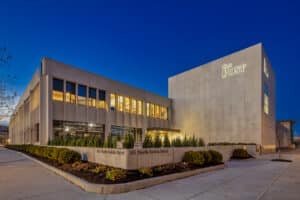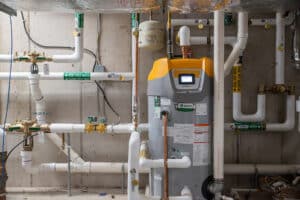Many of us spend so much time in an office environment that we hardly give a thought to the assumptions and planning that went into its design. Most of us are so caught up in the daily grind that we probably don’t think about how the environment might be impacting our productivity. The truth is that the office workplaces have long been consciously designed around the predominant office technologies, management philosophies, assumptions about efficiency, and larger cultural trends of the eras in which they were built. A look back at office designs throughout history can give us a better idea of how our workspaces evolved into their current form, and perhaps a renewed appreciation for modern ideas we take for granted like ergonomics, personal space, and computers that don’t take up an entire room.
First Half of the 20th Century – The Scientific Method
Office environments of some form or another have existed throughout recorded history; but it was only after the widespread adoption of key inventions like the telephone, the typewriter and the light bulb that the beginnings of the modern office space took root. With that in mind, the early 20th century is a good place to start our look back.
In the early decades of the 20th century, American business was heavily influenced by a management philosophy called “scientific management” (also commonly called “Taylorism” in reference to its founding father, Frederick Winslow Taylor). Scientific management was all about increasing efficiency and applying an industrial engineering type of approach to all operations in an organization, including the growing amount of office-based clerical work that was emerging in the era. When the principles of scientific management were applied to office design, the result tended to be large open spaces with desks or work tables laid out in rows resembling a military formation.
To 21st century sensibilities, offices of that era don’t exactly look comfortable or pleasant; and frankly, that was the point. Taylorism tended to see people as extensions of factory machines and offices as a type of human-powered machine. Offices of this era were designed to both literally and figuratively keep people in line. For all of the positive and lasting impacts scientific management had on the growth of modern business, it left a lot of room for improvement on the office space front.
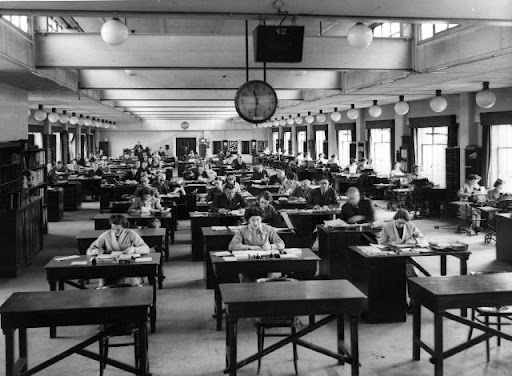
The 1950s to 1960s – Don Draper Paradise
Let us now transition to the mid-20th century. After World War II a movement began in Scandinavia and West Germany to make office environments less reflective of old style top-down hierarchies and instead, make them more democratic and generally more pleasant places to work. The idea was to design organic workspaces arranged to encourage communication and collaboration. The floorplan was open, with filing cabinets and potted plants typically serving as dividers. This concept was known by the German word Bürolandschaft (office landscaping).
Despite the European origin and terminology, popular imagination associates this style of workplace with midcentury American business at the height of its “three-martini-lunch” swagger. Many today recognize this era of office design, with its sleek modern tables, couches, and abstract wall art, from the painstaking recreations on the set of the television period drama “Mad Men.” One look at a photo of an office from this era and you can practically smell the ashtrays on the desks and hear the IBM Selectrics clacking in the background.
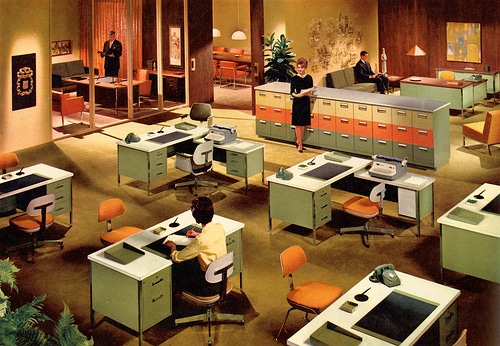
The 1970s to 1990s – Down on the Cube Farm
We are off to the 1970s and 1980s. As the modern office progressed through the ‘70s, traditional desks began to give way to a new type of personal workspace – the cubicle. It wasn’t long before seas of cubicles, sometimes derisively known as “cube farms” began to dominate the landscape of late 20th century workplaces.
The term “cubicle” has become synonymous with a certain type of bland, unpleasant work environment. The 1999 film “Office Space”, countless Dilbert cartoons, and other pop culture treatments have cemented the cubicle’s reputation as a stifling, gray box in which nobody wants to be trapped.
But, like many unpopular historical developments, cubicles began with the best of intentions. They were a logical adaptation to the lack of privacy in the open floorplan offices of the previous era. With the explosion of office computer usage in the 1980s and ‘90s, cubicles were seen as an efficient way to offer users a semi-enclosed space to focus on their screens.
The cubicle system was inexpensive for owners and developers. It offered a great deal of floor plan flexibility, which has accounted for its widespread adoption and longevity. Cubicles continue to be used in a large number of workplaces to this day. Still, many in the 21st-century workforce see “cube farms” as relics of a bygone era and symbolic of what they dislike about stereotypical office environments. In fact, a reaction to that mindset spawned some of the notable office design innovations of the following century.
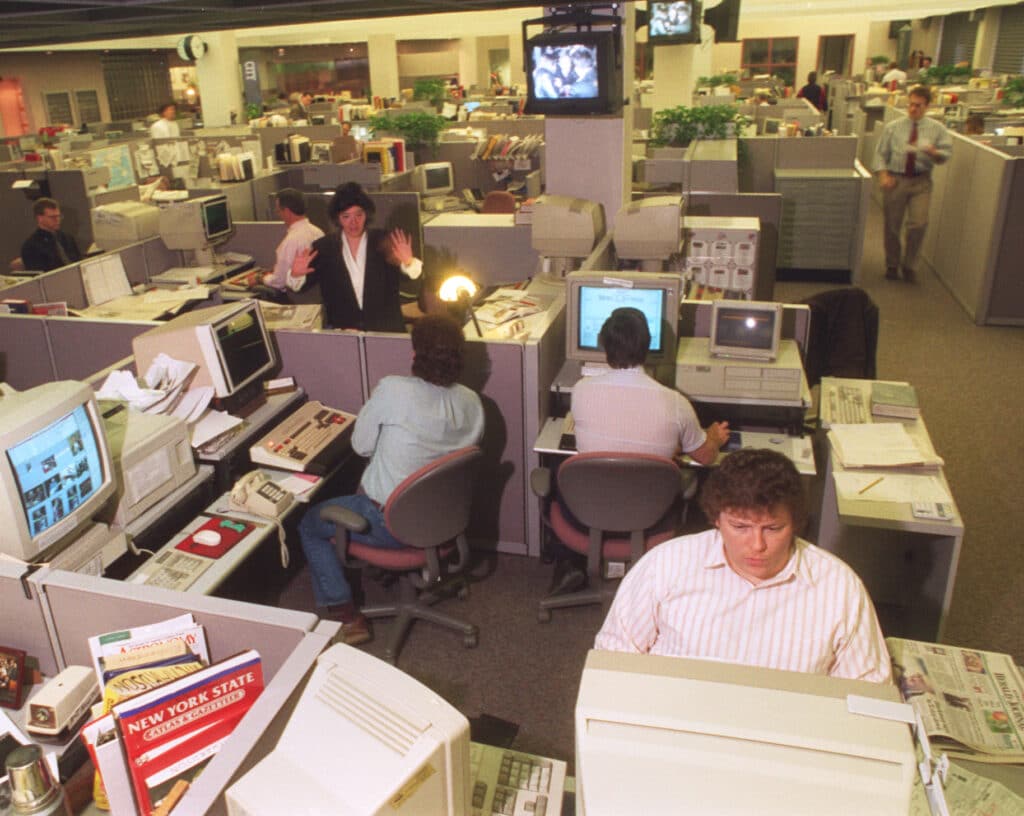
The Early 2000s – Work Hard, Play Harder
The beginning of the 21st century saw the dawn of a new kind of company, the “dot-com.” Widespread financial speculation in tech companies created an environment filled with organizations that strove to be unconventional, informal, youth-focused, and tried to grab attention with lots of flash. Nowhere was that approach more apparent than in the design of the offices of those tech start-ups.
Workplaces began featuring bean bag chairs, pool tables, and other amenities designed to make the workplace more fun. Critics saw the trend as frivolous, even childish. And the fact that so many of those rec room style offices were in companies that went under when the dot-com bubble popped didn’t help the style’s reputation.
That said, the trend did speak to the widespread desire for work environments to become less sterile and soulless. It was also a reaction to the growing reality that in a world where an increasing number of people were able to work remotely and the work itself demanded a growing degree of creativity, an organization’s common workspaces needed to offer something a little different to break up the monotony. That core assumption remains a key trend in the current era of office design.
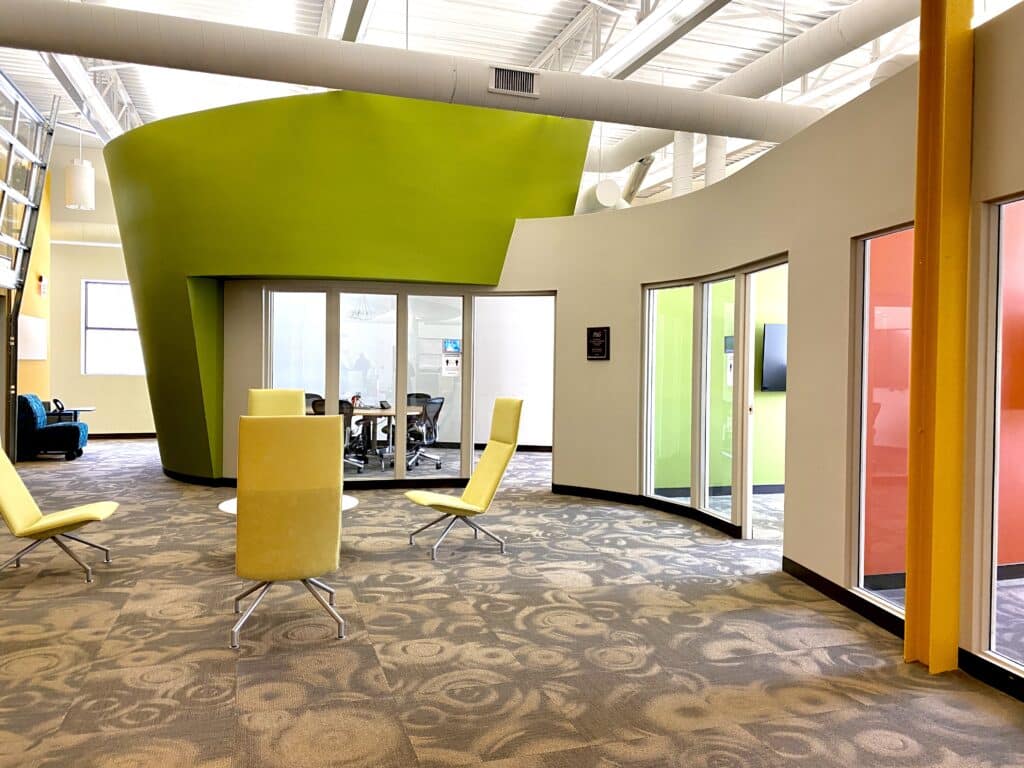
Today – Technology, Collaboration, and Engagement
Today’s office design trends represent both a continuation of what has worked in the past and a reaction to what hasn’t. Beyond that, some of them are adaptations to realities unique to this decade. Here are a few trends and guiding principles that go into creative work environments:
- Technology has changed the way we work and workspaces are changing along with that. Today’s workforce is increasingly mobile, equipped with multiple devices and likely to split time between working at the office and at home or on the road. This impacts the design of everything from desks and space devoted to individual work areas, to conference and meeting areas able to best accommodate teleconferencing.
- Flexible planning and “future-proofing” are important considerations. Because rapid technological change is a constant, it’s important that workspaces are designed in such a way that they can be reconfigured around future innovations.
- Green Building is a key priority. LEED®-certified spaces are energy efficient in the long run and in high demand by tenants. They also speak to the sustainability concerns of an increasingly environmentally-conscious workforce.
- Industrial interior design is a popular trend. In many urban areas, older industrial buildings are being refurbished and repurposed as office space. Designers update the space in such a way that combines modern amenities with the original industrial aesthetic of exposed brick, pipes, and ducts. The result is a look with a great deal of visual interest and historic charm that also saves money and provides more space flexibility by eliminating extensive drywall.
- Offices are increasingly found in mixed-use building concepts. As 21st-century cities de-industrialize, urban planning trends favor mixed-use buildings that combine office, residential, and retail space all in one structure. This trend has proven popular with professionals who wish to live and work in the same neighborhood and have easy access to retail outlets during the work day. Syracuse’s Armory Square district is a great example of an urban area that has flourished with this concept.
- Spaces are designed with team collaboration in mind. Unlike the old paradigm of work being carried out at individual desks and cubicles at fixed computer terminals, mobile devices allow for an environment where group time is more the norm than the exception.
- There is a growing awareness that the right office design can help with engagement. Employee engagement is a major priority for many organizations and these efforts can be aided with well-designed common spaces and meeting areas.
- There is an emphasis on making spaces that are appealing to workers. There has been a long, and sometimes bumpy, evolution from the stark, regimented offices of the scientific management era to places designed for human comfort and aesthetic appeal. This isn’t just to boost employees’ morale, but also to improve their productivity. A growing number of spaces are exhibiting features of what is called “biophilic” design. Biophilic principles include an emphasis on natural lighting, environmental features such as plants and water, and natural shapes and surfaces, to name just a few.
- The push toward more pleasant, naturalistic workplace environments in the modern office has also increased the incorporation of outdoor working spaces such as patios, rooftop terraces, and courtyards. Such features can make the office feel less confining and provide a pleasant venue for collaboration and team engagement.
Regardless of what an organization does or wants to become, the physical space in which its people work and interact will be a vital factor in its success and should never be treated as an afterthought.


